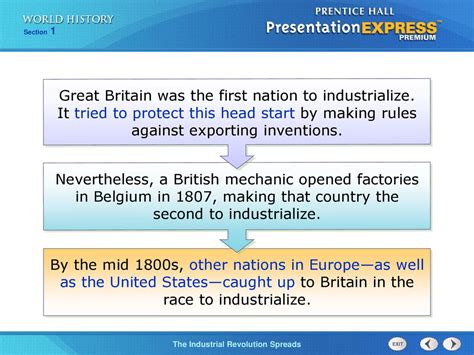The Industrial Revolution was a period of major technological and social change that began in Great Britain in the mid-18th century and spread to other parts of Europe and the world. It marked the transition from an agrarian and handicraft economy to one based on industry and manufacturing.

Great Britain: The Pioneer of Industrialization
Great Britain emerged as the first industrialized nation in Europe thanks to a combination of factors, including:
- Abundant natural resources: Rich coal and iron ore deposits provided the raw materials for industrial production.
- Political stability: A stable government and a strong legal system created a favorable environment for investment and innovation.
- Growing population: A rapidly growing population provided a large labor force for factories.
- Capital accumulation: A wealthy merchant class had accumulated capital through trade and commerce, which they invested in industrial ventures.
- Entrepreneurial spirit: British inventors and entrepreneurs were eager to experiment with new technologies and develop new products.
Key Innovations of the British Industrial Revolution
The Industrial Revolution was characterized by numerous technological breakthroughs, including:
- Steam engine: Invented by James Watt, the steam engine provided a powerful source of energy for factories and transportation.
- Spinning jenny and cotton gin: These inventions revolutionized the textile industry, enabling mass production of cotton fabrics.
- Power loom: Invented by Edmund Cartwright, the power loom automated weaving, increasing efficiency and productivity.
- Iron and steel production: New techniques improved the production and use of iron and steel, used for manufacturing machinery and construction.
- Transportation: Improvements in canals, roads, and railways facilitated the movement of goods and people.
Economic and Social Impacts of Industrialization
The Industrial Revolution had a profound impact on British society and economy:
- Economic growth: Industrialization led to a surge in economic growth, productivity, and wealth.
- Urbanization: The growth of factories and industries led to the rapid expansion of cities, with people migrating from rural areas to urban centers.
- Social changes: New social classes emerged, including the industrial working class and the capitalist bourgeoisie.
- Environmental impact: Industrialization resulted in increased pollution and environmental degradation.
Spread of Industrialization to Europe
After Great Britain, other European countries also began to industrialize, following its lead:
- Belgium: With its rich coal and iron ore resources, Belgium became a major industrial center in the 19th century.
- France: France experienced industrial growth in the mid-19th century, particularly in sectors such as textiles, iron, and steel.
- Germany: Germany emerged as an industrial powerhouse in the late 19th century, driven by heavy industry and technological advancements.
- United States: The United States followed Europe in the industrialization process and rapidly became a global industrial leader by the early 20th century.
Table 1: European Countries Ranked by Industrialization
| Rank | Country | Industrialization Period |
|---|---|---|
| 1 | Great Britain | Mid-18th century |
| 2 | Belgium | Early 19th century |
| 3 | France | Mid-19th century |
| 4 | Germany | Late 19th century |
| 5 | United States | Late 19th century |
Table 2: Key Innovations of the British Industrial Revolution
| Invention | Inventor | Impact |
|---|---|---|
| Steam engine | James Watt | Provided power for factories and transportation |
| Spinning jenny | James Hargreaves | Automated cotton spinning |
| Cotton gin | Eli Whitney | Removed seeds from cotton fibers |
| Power loom | Edmund Cartwright | Automated weaving |
| Bessemer process | Henry Bessemer | Improved iron and steel production |
Table 3: Economic Impacts of the Industrial Revolution
| Impact | Description | Example |
|---|---|---|
| Economic growth | Increased productivity and wealth | GDP growth of 5% per year in Great Britain |
| Urbanization | Migration to cities | Population of London tripled in 50 years |
| Social changes | New social classes and economic inequality | Emergence of the industrial working class |
| Environmental impact | Increased pollution and environmental degradation | Air pollution from coal-fired factories |
Table 4: Spread of Industrialization to Europe
| Country | Industrialization Period | Key Industries |
|---|---|---|
| Belgium | Early 19th century | Coal, iron, steel |
| France | Mid-19th century | Textiles, iron, steel |
| Germany | Late 19th century | Heavy industry, technology |
